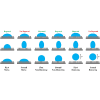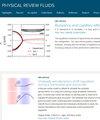Impact dynamics of nanodroplets on pillared surfaces
IF 2.5
3区 物理与天体物理
Q2 PHYSICS, FLUIDS & PLASMAS
引用次数: 0
Abstract
This work investigates impacting nanodroplets on pillared surfaces via molecular dynamics (MD) simulations, especially to understand the intrusion effect of liquid in pillar gaps at the nanoscale, by comprehensively revealing outcome regimes and modeling the maximum spreading factor . A total of six outcomes, including first sticky (1S), second sticky (2S), first nonbouncing (1NB), second nonbouncing (2NB), first bouncing (1B), and second bouncing (2B), are identified. The 1S, 2S, and 2B regimes take place on monostable Wenzel surfaces with the Wenzel-to-Cassie dewetting transition and bouncing boundaries separating them; the 1NB, 2NB, 1B, and 2B regimes occur on monostable Cassie surfaces, distinguished by the Cassie-to-Wenzel wetting transition and bouncing boundaries. By establishing criteria of all boundaries, a universal phase diagram of impacting nanodroplets on pillared surfaces is constructed. Besides, to understand the altered spreading dynamics by the liquid intrusion effect, is modeled. The bulk droplet above pillared surfaces is found to have the same spreading dynamics as a nanodroplet on flat surfaces, which decouples the effects of the bulk droplet and the liquid intruding into pillar gaps. Subsequently, two intrusion regimes are classified based on different intrusion morphology of the liquid front, and the scalings for intrusion volume in different intrusion regimes are obtained with the corresponding transition criterion being proposed. Eventually, scaling laws of for impacting nanodroplets on pillared surfaces are established by incorporating the volume term of the bulk droplet, and are in good agreement with all available MD data of , showing their strong robustness and universality.

柱状表面上纳米液滴的撞击动力学
这项工作通过分子动力学(MD)模拟研究了柱状表面上的纳米液滴撞击,特别是通过全面揭示结果机制和最大扩散因子(βmax)建模,了解液体在纳米尺度上对柱状间隙的侵入效应。共确定了六种结果,包括第一粘滞(1S)、第二粘滞(2S)、第一不弹跳(1NB)、第二不弹跳(2NB)、第一弹跳(1B)和第二弹跳(2B)。1S、2S 和 2B 状态发生在单稳态温泽尔表面上,温泽尔到卡西的润湿转变和弹跳边界将它们分开;1NB、2NB、1B 和 2B 状态发生在单稳态卡西表面上,卡西到温泽尔的润湿转变和弹跳边界将它们区分开来。通过建立所有边界的标准,构建了柱状表面上撞击纳米液滴的通用相图。此外,为了理解液体侵入效应改变的扩散动力学,还建立了 βmax 模型。结果发现,柱状表面上的大液滴与平面上的纳米液滴具有相同的扩散动力学,这就将大液滴和侵入柱状间隙的液体的效应分离开来。随后,根据液体前沿的不同入侵形态划分了两种入侵状态,并得到了不同入侵状态下的入侵体积标度,提出了相应的过渡准则。最后,通过加入大量液滴的体积项,建立了撞击柱状表面纳米液滴的 βmax 缩放定律,并与所有可用的 βmax MD 数据良好吻合,显示了其很强的鲁棒性和普遍性。
本文章由计算机程序翻译,如有差异,请以英文原文为准。
求助全文
约1分钟内获得全文
求助全文
来源期刊

Physical Review Fluids
Chemical Engineering-Fluid Flow and Transfer Processes
CiteScore
5.10
自引率
11.10%
发文量
488
期刊介绍:
Physical Review Fluids is APS’s newest online-only journal dedicated to publishing innovative research that will significantly advance the fundamental understanding of fluid dynamics. Physical Review Fluids expands the scope of the APS journals to include additional areas of fluid dynamics research, complements the existing Physical Review collection, and maintains the same quality and reputation that authors and subscribers expect from APS. The journal is published with the endorsement of the APS Division of Fluid Dynamics.
 求助内容:
求助内容: 应助结果提醒方式:
应助结果提醒方式:


